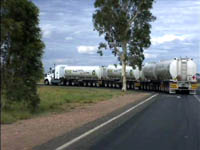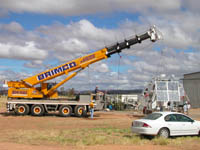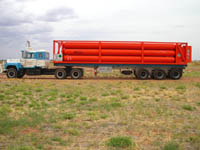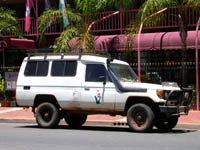 Australia is known for its multi-trailer trucks that are called "road trains". This is a picture that Bob Hull took of one. It is really quite impressive when they pass you on a
narrow road moving in the other direction at high speed.
Australia is known for its multi-trailer trucks that are called "road trains". This is a picture that Bob Hull took of one. It is really quite impressive when they pass you on a
narrow road moving in the other direction at high speed.
 While I was at
Ormiston Gorge, they were doing repair work on one of the rocky trails. To get
cement and other gear up there, they were using this helicopter. When I got to
Glen Helen a few hours later (which is only about 20 km away), I saw they had an
empty helipad for sightseeing flights. I assume this is where this helicopter
came from.
While I was at
Ormiston Gorge, they were doing repair work on one of the rocky trails. To get
cement and other gear up there, they were using this helicopter. When I got to
Glen Helen a few hours later (which is only about 20 km away), I saw they had an
empty helipad for sightseeing flights. I assume this is where this helicopter
came from.
 This is
the large crane that will be used to launch NIGHTGLOW (shown here with
NIGHTGLOW suspended). It had to be driven up from Adelaide (>1000 miles
away), because there wasn't a crane big enough in Alice Springs. Its job
is to hold NIGHTGLOW up off the ground and then actively maneuver
NIGHTGLOW under the balloon as it is rising up. When the balloon is fully
extended and NIGHTGLOW is positioned directly underneath, the crane
releases NIGHTGLOW and away it goes.
This is
the large crane that will be used to launch NIGHTGLOW (shown here with
NIGHTGLOW suspended). It had to be driven up from Adelaide (>1000 miles
away), because there wasn't a crane big enough in Alice Springs. Its job
is to hold NIGHTGLOW up off the ground and then actively maneuver
NIGHTGLOW under the balloon as it is rising up. When the balloon is fully
extended and NIGHTGLOW is positioned directly underneath, the crane
releases NIGHTGLOW and away it goes.
 This is the tractor trailer full of helium that is needed to fill the balloon.
This is the tractor trailer full of helium that is needed to fill the balloon.
 This is
a custom launch vehicle called the spool truck. It has a large metal
cylinder (shaped like a spool of thread) that is hinged on one side and
has strong springs. The other side has a quick release latch. The top of
the balloon is threaded under the spool, and that is the part that they
fill with helium. As more of the balloon fills up, the spool truck is
moved along the balloon, keeping the un-inflated portion of the balloon stretched out across the ground, and providing enough weight to keep the balloon on the ground. Even when they're ready to launch, most of the balloon is not inflated. The helium gas will expand by more than a factor of 200 by the time it gets up to float altitude (~110,000 feet), so the balloon looks mostly empty at sea level. At launch time, the latch on the spool is released and the spool springs upright, releasing the balloon quickly and smoothly.
This is
a custom launch vehicle called the spool truck. It has a large metal
cylinder (shaped like a spool of thread) that is hinged on one side and
has strong springs. The other side has a quick release latch. The top of
the balloon is threaded under the spool, and that is the part that they
fill with helium. As more of the balloon fills up, the spool truck is
moved along the balloon, keeping the un-inflated portion of the balloon stretched out across the ground, and providing enough weight to keep the balloon on the ground. Even when they're ready to launch, most of the balloon is not inflated. The helium gas will expand by more than a factor of 200 by the time it gets up to float altitude (~110,000 feet), so the balloon looks mostly empty at sea level. At launch time, the latch on the spool is released and the spool springs upright, releasing the balloon quickly and smoothly.
 This is a local truck that has been modified for the outback. There are quite a few of them around. You can see a "Roo Bar" or "Bull Bar" on the front which protects the grill from kangaroo and livestock impacts (which are frequent in the evening and at night). You can also see, running from above the front wheel and up between the windshield and the driver's window, a snorkel. This allows the truck to ford the occasional stream. This is not only needed when you travel overland, it is sometimes needed on the highways. Because most of the rivers around here are usually dry, it is frequently not economical to build a bridge. The road just runs across the river bed (see my Jan. 31 journal entry). That works 95% of the time. This truck also has two spares on the back (not seen in the photo), because the spinifex grass is so treacherous.
This is a local truck that has been modified for the outback. There are quite a few of them around. You can see a "Roo Bar" or "Bull Bar" on the front which protects the grill from kangaroo and livestock impacts (which are frequent in the evening and at night). You can also see, running from above the front wheel and up between the windshield and the driver's window, a snorkel. This allows the truck to ford the occasional stream. This is not only needed when you travel overland, it is sometimes needed on the highways. Because most of the rivers around here are usually dry, it is frequently not economical to build a bridge. The road just runs across the river bed (see my Jan. 31 journal entry). That works 95% of the time. This truck also has two spares on the back (not seen in the photo), because the spinifex grass is so treacherous.
This file was last modified February 15,
2003